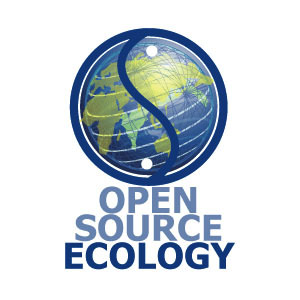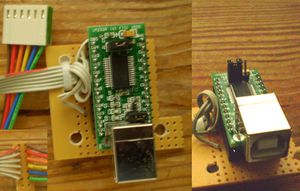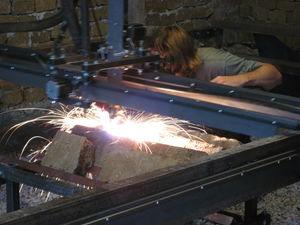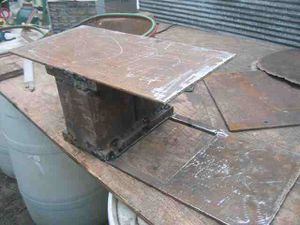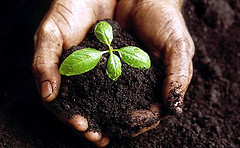FAQ
Frequently Asked Questions
Open Source Ecology
Our vision is very ambitious. We are hacking society.
We are building a set of machines for creating a self-sufficient modern life from low-grade, abundant local resources. Further, we hope to build the infrastructure to allow people to share the information needed to redesign, repair and re-imagine this set, to develop networks for sharing skills and raw materials, and to help each other perfect a vision of self-sufficient living.
We hope that having survival needs taken care of outside of the current order will give people the freedom to become deeper, more thoughtful, more creative human beings. By giving people a means to live a modern life that is closely connected to the land that sustains them, we hope to help them become careful stewards of the land. This way of life may change the game for human survival on this planet.
Isn't this just revisiting the back to the land movement of the 1970s?
It's more than that. How farms operate has changed dramatically since the 1970s. On most commercial farms, mechanization has increased steadily, while new seed, fertilizer, and irrigation technologies have increased production dramatically. There has also been significant research and development in both biointensive agricultural techniques and permaculture. These techniques helped make intensive food production that improves soils and requires little to no ongoing input of resources possible for many small farms and communities. Some mechanization and technology is synergistic with these techniques in ways that maintain their ethos of ecological responsibility. Given this, there are many new possibilities for what a self-sufficient community can be.
The internet has also changed what a self-sufficient community can be. The internet makes it easy to share knowledge and collaborate on problems with people who are far away. This makes bazaar-style open-source software development possible, and it’s starting to have the same effect on hardware. Automated fabrication — computer numerical control — could make it possible to do a lot of machinery design and construction with less labor and less capital investment than was needed back in the 1970s.
Biointensive agriculture and permaculture are powered by design. It is now possible to share design development and improvement of agricultural systems in ways not possible before interconnectivity through the internet. We can develop a truly open source permaculture. OSE is also working to create RepLab, a digital fabrication workshop. A functioning workshop could allow people to instantly share plans across the internet and produce machines and machine parts on a small scale in a short time frame.
Response adapted from a comment by Kragen Javier Sitaker on | hackaday.com
Why use machines? Aren't traditional farming methods less wasteful and toxic?
Why use machines? Time. Subsistence farming is exceptionally labor intensive. Modern tools bring the power to lessen labor burdens and increases quality of life substantially.
An integral part of our work is creating industrial processes that are fully in harmony with ecologically responsible living. We are pursuing completely closed ecological industrial cycles, with which there is no waste. Right now we are building tools and machines to get us to this point. Developing the prototypes and first builds of the #Global Village Construction Set does require some industrial inputs from outside, along with their negative impacts. This a preliminary step needed to take us deeper into the process of creating a truly ecological approach to technologically modern self-sufficient living.
Isn't mass production and specialization more efficient/better?
Mass production can be far more efficient, and much of this efficiency is gained through the externalization of costs. There are a number of negative externalities usually produced by business-as-usual production that are not factored into market cost:
- Transportation: Taxpayers paying for roads are subsidizing distribution costs.
- Pollution: Water, soil, air, and noise pollution cost everyone, most intensely the economically disadvantaged. It is often the case that when industrial pollution is tolerated, products cost less. It can be more efficient to avoid environmental remediation.
- Worker alienation: Treating workers as valued contributors often runs counter to goals of efficiency.
- Aggregation of wealth: Centralized production is especially conducive to centralization of wealth.
Certainly, some industries gain more efficiency through externalization of costs than others. It may be that mass production of some things will continue to be preferable, but what those things are remains to be seen. Open Source Ecology seeks to create technologies that do not rely on these negative externalities for efficiency. When these externalities are factored into efficiency calculations, one finds in many cases that it is more efficient for communities to produce their own goods, by a factor of 5-10. The implications for liberation are profound.
Further, greater efficiency can be undesirable. Increasingly efficient systems can become very reliant on a certain set of external conditions to allow them to function. In the rare event that a major shift were to occur, much of business-as-usual production could suddenly lose its ability to operate and would have to transform rapidly at great cost or perish. OSE is working to allow people to build resilient communities that are tied only to the land, allowing them to weather a wide variety of external changes.
Doesn't this ignore the global trend of urbanization?
In theory, this approach is modular and scalable to larger communities and greater population densities. The limit to population density arises from finite sunlight energy and limited resources. Sunlight energy is currently intensely underutilized, while using technological resources in a closed eco-technological cycle reduces resource inputs as it reduces waste. Food production at high population densities might not look much like traditional farming, but it does at least theoretically jive with what OSE is creating. Other implications of large-scale settlements need to be explored.
Our analysis indicates that about 200 people is the minimum needed to produce all the items present in modern civilization, including semiconductor and microelectronics fabrication up to the level of 1990s technology. The analysis involves assessing the range of the various material and product needs of civilization, along with the labor/machine/skill requirements for each product. Whether larger communities are desirable has yet to be seen.
Global Village Construction Set
We are building new machines by recombining existing technologies. The Global Village Construction Set is designed to become a fully integrated set of machines for creating a self-sufficient modern life from the resources of a small amount of land.
The plan for the GVCS has 3 levels, each taking the project a step farther away from reliance on outside inputs:
- Level 1: Building a set of machines as complete products using off-the-shelf components.
- Level 2: Building tools to build components for the machines of level 1.
- Level 3: Building machines and processes to introduce raw materials into an ecological industrial cycle to serve as materials for the components of level 2.
See a summary of our current progress.
Why not buy these tools and machines at my local store?
Farm and construction implements bought in the current market are limited because their designs are the intellectual property of the companies that produce them. This results in low accountability. While higher quality, cheaper machines would fare better in a pure market system, the market system we're working our way out of is far from pure. This results in higher prices. Drastic cost reduction is a well-known feature of open source products. See a graph estimated price comparisons.
- Reasons proprietary technologies are more costly:
- Planned obsolescence: Companies routinely sell products with a limited useful life in order to maximize profits. When products wear out quickly, sales go up. The overall cost is much higher than the cost of buying one quality product.
- Competition through advertising: Rather than competing by reducing prices or increasing product quality, entire industries may set uniformly high prices while companies in that industry compete with each other through advertising only. The consumer loses.
- Regulated repair: Proprietary technologies require keeping users in the dark about machines' design and inner workings. Warranties discourage tinkering by requiring repair by licensed repair technicians. This repair can be very costly, and add greatly to the overall cost of the machine.
- Advantages of OSE technologies:
- Lifetime design: The technologies of the GVCS are designed to be easily taken apart and fixed. These simpler machines are built to last a lifetime.
- Collaborative development: We are also documenting our plans with open source licenses so that anyone may replicate our designs. Open source development can reduce design inefficiencies. More minds and hands devoted to a problem can lead to solutions for building at a lower cost, in less time, and with fewer resources.
- Design as a set: The GVCS is being developed with a modular design that greatly reduces waste. For example, one power source can be switched from machine to machine, saving the resources one would need to have a separate power source for each.
- Modification: Because the plans are open, the tools and machines can be remixed, tweaked, and built upon. They can be disassembled and combined into new creations, modified to function better in specific environments and for particular purposes, or added to for additional utility.
- Self-replication: The GVCS, once fully developed, is designed to be self-replicating. Buying into the development of this set could mean never having to buy a new implement again.
Why didn't you choose (a different technology) for the GVCS?
The Global Village Construction Set is designed to be sufficient to provide the food, energy, housing, and technology needs of advanced civilization. We are choosing elements for the set that are:
- Proven technologies, requiring no new inventions
- The simplest possible that serve our goals
- In line with the OSE Specifications
Our choices are not set in stone. Along with developing and testing these tools and machines, we are beginning to use them to support ourselves. This is a tough test of their true effectiveness. If it becomes clear that a different technology would be better for achieving our goals, it will be included.
All the important parts are made in China. How is this building self sufficiency?
Open Source Ecology is working on building the machines of Global Village Construction Set in parallel with the tools needed to fabricate them. This project is in its early stages. The complete GVCS is designed with the capacity to fabricate all of the parts needed to make a copy of the whole set from raw materials. Going deeper, some technologies for extracting/refining raw materials for the set from abundant, low grade natural resources are in their planning stages. When the first set is complete, inputs of commercially manufactured components will no longer be required. Given, it will take a lot of work to get there. See the levels of the GVCS.
Early stages of the GVCS do require parts from China. Later stages will not, as the ability to build open source versions of those parts comes online. The project is using some of the products of global society to create the tools to subvert it, taking the harvest for the seed.
Where can I find plans?
Plans are currently spread out over multiple pages for each technology. Check the GVCS tools page and explore the categories in the 'other wiki articles' column to get quickest access to schematics, drawings, and plans. As we become more organized, and the project becomes more developed, there will be more to access and it will be easier to access.
What kind of license are you using?
A comprehensive licensing strategy is currently being developed. Check back later.
Do these machines have any relevance in the third world? Aren't they too costly?
The construction of the first GVCS, while cheaper than its commercial counterparts, is taking a significant amount of outside investment and resources. However, the set is designed to be self-replicable. This means that the cost of building subsequent sets will be much lower, a feature that may make the GVCS a feasible option for those living in poverty. A bigger hurdle is cultivating the skill sets needed to construct and maintain the GVCS. Innovative solutions are needed to facilitate a widespread adoption of the GVCS.
Could I build a business around this?
Yes. We encourage the use of an open source business model. When people say Open Business Model, typically, people mean that the subject matter of a business model is open source. OSE goes a step further. We hope to foster the sharing not just of how to build a product, but how to market and sell it, how to organize effectively, and other important practices and processes. The business model itself is open source.
This means giving up advantages gained through proprietary information. A prospective business owner would have to accept total free enterprise, as open source plans eliminate barriers to entry for other players. In exchange, the prospective owner would gain the advantages of having a team of volunteer developers. We believe a proprietary effort can never be as effective as an open source effort because once a certain number of open source contributors are found, product quality begins to surpass anything possible with limited proprietary funding.
Open source businesses generally create revenue by offering services related to an open source project. For example, you might create a revenue stream through offering supplementary services around the GVCS, such as building the machines for others or using the machines to offer services to others. Open source business models for software can be seen in action, but these models have not been well explored in the realm of hardware development. The viability of such a project has yet to be proven.
You say it's free yet you ask for money. How come?
- In English, but not in other languages, "free" can mean both "freedom" and "zero money", and you need to look at the context to decide which meaning is being used in a given circumstance. The GVCS will be free in the sense of "freedom": anyone will be able to download our documentation and make copies of it. Anyone will be able to build machines without paying (us or anyone) for that right. If information is distributed in a DVD, a price may be charged for the medium and the work of making a copy, but the information is still free in terms of your freedom to use it and distribute it.
- Of course, we as developers need money to sustain our developement effort: if we work on a prototype for several weeks, we need to eat to stay alive, and we also need to buy parts, write documentation, and a variety of other tasks. That money comes from True Fans, from specific donations, and from our first sales.
- Later, when the machines are documented, ourselves and other people will take on a different role, not as developers (which is a one-time activity) but as makers (which happens once for every machine that's built for somebody else). If someone makes a machine for you, they can of course charge for their work, for the price of the parts, and get some reasonable profit - just like in any other sale in the world.
- A common phrase in the Open Source Movement compares Free Speech and Free Beer. Free speech means freedom. For beer, it does cost money to feed the inventor, and it does cost money to fill each glass. But you are free (as in freedom) to pass around the recipe.
- In short, we need some money to create free(dom) recipes. Once done, the recipes will be available to everyone at no cost. You'll be free(dom) to make the machines, and also free(dom) to pay for others to make the machines for you.
How can I help the project?
We are looking for many kinds of help from people of all types, places, and skill sets. We're seeking donations of time, money, expertise and materials. We're also searching out contractors for some project development and grant writing tasks. Find out what you can do to get involved and keep this project moving forward.
